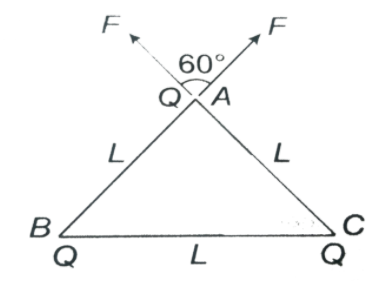
Three identical particles each of mass $m$ are placed at the corners of the equilateral triangle at side $a$. Find the gravitational force exerted on one body due to the other two.
Answer
218.7k+ views
Hint: We have an equilateral triangle whose all angles are equal to $60^\circ $ . We have to use the formula of gravitational force which is equal to $\overrightarrow F = G\dfrac{{Mm}}{{{r^2}}}$. After that for net force add both the forces which act on it due to both sides.
Complete step by step solution:
We have an equilateral triangle whose all sides are equal and angles are of $60^\circ $. Now let $L = a$ be the side of a triangle.

Here all the particles are of the same mass as $m$.
We will use Newton's laws to solve this question. Newton's law of universal gravitation says that every particle attracts every other particle in the universe with a force that is directly proportional to the product of their masses and inversely proportional to the square of the distance between their centers. Therefore,
$\overrightarrow F = G\dfrac{{Mm}}{{{r^2}}}$
Now put the values, calculate magnitude of force due to particle B, we get
${\overrightarrow F _1} = G\dfrac{{{m^2}}}{{{r^2}}}$
Now calculate magnitude of force due to particle C, we get
${\overrightarrow F _2} = G\dfrac{{{m^2}}}{{{r^2}}}$
Now, we are given that both the forces are at $60^\circ $ . Therefore net force is equal to
$\overrightarrow {{F_{net}}} = \overrightarrow {{F_1}} + \overrightarrow {{F_2}} $
And the magnitude of this net force will be
$ \Rightarrow \sqrt {{F^2}_1 + {F_2}^2 + 2{F_1}{F_2}\cos 60°} $
After putting the value of $\cos 60$ , we get
$ \Rightarrow \sqrt {{F^2} + {F^2} + 2{F^2} \times \dfrac{1}{2}}$ (since $\cos 60° = \dfrac{1}{2}$ )
$ \Rightarrow \sqrt {3{F^2}} $
Hence, we get the net force equal to
${F_{net}} = \sqrt 3 F$
And lastly put value of $F$ to get the final answer
${F_{net}} = \sqrt 3 G\dfrac{{{m^2}}}{{{r^2}}}$
This is the value asked in the question.
Note: Always remember about the units of quantities. Here, the mass of all the particles is the same so refer to them with the same name and also remember that force is a vector quantity so direction matters.
Complete step by step solution:
We have an equilateral triangle whose all sides are equal and angles are of $60^\circ $. Now let $L = a$ be the side of a triangle.

Here all the particles are of the same mass as $m$.
We will use Newton's laws to solve this question. Newton's law of universal gravitation says that every particle attracts every other particle in the universe with a force that is directly proportional to the product of their masses and inversely proportional to the square of the distance between their centers. Therefore,
$\overrightarrow F = G\dfrac{{Mm}}{{{r^2}}}$
Now put the values, calculate magnitude of force due to particle B, we get
${\overrightarrow F _1} = G\dfrac{{{m^2}}}{{{r^2}}}$
Now calculate magnitude of force due to particle C, we get
${\overrightarrow F _2} = G\dfrac{{{m^2}}}{{{r^2}}}$
Now, we are given that both the forces are at $60^\circ $ . Therefore net force is equal to
$\overrightarrow {{F_{net}}} = \overrightarrow {{F_1}} + \overrightarrow {{F_2}} $
And the magnitude of this net force will be
$ \Rightarrow \sqrt {{F^2}_1 + {F_2}^2 + 2{F_1}{F_2}\cos 60°} $
After putting the value of $\cos 60$ , we get
$ \Rightarrow \sqrt {{F^2} + {F^2} + 2{F^2} \times \dfrac{1}{2}}$ (since $\cos 60° = \dfrac{1}{2}$ )
$ \Rightarrow \sqrt {3{F^2}} $
Hence, we get the net force equal to
${F_{net}} = \sqrt 3 F$
And lastly put value of $F$ to get the final answer
${F_{net}} = \sqrt 3 G\dfrac{{{m^2}}}{{{r^2}}}$
This is the value asked in the question.
Note: Always remember about the units of quantities. Here, the mass of all the particles is the same so refer to them with the same name and also remember that force is a vector quantity so direction matters.
Recently Updated Pages
Two discs which are rotating about their respective class 11 physics JEE_Main

A ladder rests against a frictionless vertical wall class 11 physics JEE_Main

Two simple pendulums of lengths 1 m and 16 m respectively class 11 physics JEE_Main

The slopes of isothermal and adiabatic curves are related class 11 physics JEE_Main

A trolly falling freely on an inclined plane as shown class 11 physics JEE_Main

The masses M1 and M2M2 M1 are released from rest Using class 11 physics JEE_Main

Trending doubts
JEE Main 2026: Application Form Open, Exam Dates, Syllabus, Eligibility & Question Papers

Derivation of Equation of Trajectory Explained for Students

Hybridisation in Chemistry – Concept, Types & Applications

Understanding the Angle of Deviation in a Prism

Understanding Collisions: Types and Examples for Students

Understanding Atomic Structure for Beginners

Other Pages
JEE Advanced Marks vs Ranks 2025: Understanding Category-wise Qualifying Marks and Previous Year Cut-offs

Units And Measurements Class 11 Physics Chapter 1 CBSE Notes - 2025-26

NCERT Solutions For Class 11 Physics Chapter 8 Mechanical Properties Of Solids

Motion in a Straight Line Class 11 Physics Chapter 2 CBSE Notes - 2025-26

NCERT Solutions for Class 11 Physics Chapter 7 Gravitation 2025-26

How to Convert a Galvanometer into an Ammeter or Voltmeter




